| |
|
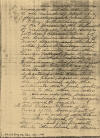
|
April 6, 1929.
Operations Agreement between Capt. G. F.
Stockes, USMC, and Jefes Expedicionarios
Felipe F. Flores, José A. Sánchez y Juan B.
Mendoza (English translation only), p. 1.
"Las
Manos, Honduras, Nicaragua, on the 6th day
of the month of April 1929, the undersigned,
Gen. Felipe T. Florez, Expeditionary Chief
of the forces of the Government of
Nicaragua, Capt. George Stockes,
Representative of the Commander General of
Nueva Segovia and the Generals Juan B.
Mendoza and Jose A. Sanchez and the lawyer
(attorney) Jose B. Henriquez in their
capacity of Expeditionary Chiefs the first
two and the last as Jefe Director and
Expeditionary Delegate for the Executive
Power, have agreed upon the following after
the statements that each party made to the
other in order to clean up the border of
Honduras and Nicaragua in regard to bandits:
¶ 1st. The Representatives of the
Forces of the Government of Nicaragua and
the Commander General of Nueva Segovia, Col.
J. A. Rossell, bind themselves to discon- .
. . "
|
|
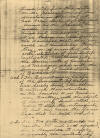
|
April 6, 1929.
Operations Agreement between Capt. G. F.
Stockes, USMC, and Jefes Expedicionarios
Felipe F. Flores (Nicaragua), José A. Sánchez
(El Paraiso, Honduras) and Juan B.
Mendoza (San Marcos de Colón, Honduras) (English translation only), p. 2.
". . . tinue (stop)
from this date on the persecution of
Sandinistas in the way it has been done by
the Ame aviones [American airplanes] on the
border of Honduras and Nicaragua, because it
is taken in consideration the damages that
they may cause on Honduran territory, on
account of the good relations of friendship
cultivated (maintained) by the Governments
of Honduras and Nicaragua and with the
Government of United States of America.
¶ 2nd. The Expeditionary Chiefs of the
Government of Honduras hereby bind
themselves to continue their activities on
the border or on Honduran territory, with
the object of disarming Sandinistas, in
order to stop the intranquility that they
cause the families that on said borderline.
¶ 3rd. The two parts mentioned on
Number 1st and 2nd aforesaid, bind
themselves to comply reciprocally the
contents of . . . "
|
|
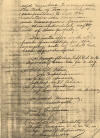
|
April 6, 1929.
Operations Agreement between Capt. G. F.
Stockes, USMC, and Jefes Expedicionarios
Felipe F. Flores, José A. Sánchez y Juan B.
Mendoza (English translation only), p. 3.
" . . . said numbers
to accomplish the task of tranquilization
(pacification) and to maintain the Honduran
and Nicaraguan families in their individual
safety and of their property. ¶
The parts offer each other frank friendship
for the carrying out of what has been agreed
upon. ¶ (s) George Stockes,
Capt. U.S.M.C. By order of Com. Gen. for N.
Seg. ¶ (s) Felipe T. Florez,
Jefe Expedicionairio. ¶ (s) Juan
B. Mendoza, Jefe Expedicionario de San
Marcos ¶ (s) José D. Henriquez,
delegate. ¶ José J. Espinosa,
secretary. ¶ (Translated
specially for Capt. Reagan, U.S.M.C. by José
J. Espinosa. May 11, 1929."
|
|

|
April 8, 1929.
USMC Captain George F.
Stockes on the combined Marine-Voluntario
offensive in the Western Segovian
borderlands.
[NOTE:
This material was extracted from an R-2
serial intelligence report from Ocotal of 8
April 1929, covering a two-week period, and
also appears in the
TOP
100 PAGE 33.
Source: IR29.04.08, in RG127/209/1]
" . . .
[March 27] . . . From Capt. Stockes,
Mar. 27: After my departure from Somoto
received message from [Honduran
Expeditionary Chief Juan B.] Mendoza that he
would confer with me in Calpules. He moved
North along the border and arrived here 2300
yesterday. Hakala column cleared Santa
Emilia 0400 and arrived here via border
trails at 1030. Stockes column cleared
Yaraje at 0430 via Jocomico and arrived here
1100. Conference immediately with Gen.
Mendoza who has 50 men and is camped here on
the Honduran side. Col. Abie Vallodarez
[Ballardes] had conference with Salgado
[EDSN General Carlos Salgado] yesterday. He
was representing Mendoza and offered Salgado
a guarantee in Honduras if he would
surrender with his force. Salgado has 50
armed men. He requested 8 days armistice in
which to decide and expressed a desire to
have a conference with my column. Vallodarez
told him no armistice could be arranged
until after he had talked with me. Salgado
left following the border trail North toward
Bado Grande. Neither Mendoza nor I believe
Salgado is sincere. He is in a bad way and
only trying to get us off the trail for the
time being. We move after him, Mendoza
stating he will continue to operate along
the border on the Honduran side. Patrol
dispatched from Yaraje yesterday captured
commandant of Bandit Civicos of Las
Cabullas. Have also taken into custody
several other bandit supporters and turned
over to Mendoza list of suspects who have
fled to Honduras. . . . [ p. 4 ] . . .
¶ [March 27] . . . [From Lt.
Hamas] 27 March, 1929. Las Manos. Arrived at
12:30 a.m., native agent reports Salgado at
Pedregalito, Ortez at Las Limas, Area
Commander notified. . . . [p. 9 ] . .
. ¶ [March 27] . . . From
C.O., G.N., Dipilto, Mar. 27: Native
reported that Salgado is in Pedregalito,
Honduras, according to same report Ortez is
at Las Limas, Honduras. Ortez was seen
passing through Las Manos with cargo of
coffee at midnight March 23. Lt. Hamas'
patrol has searched El Naranjo and El Poste,
La Laguna, Cabo Blanco in Las Manos area.
Request further instructions at Las Manos.
Hamas. . . . [ p. 5 ] . . . ¶
[March 28] . . . Lt. Hamas and 15
Guardias patrolled Suyatal, El Horno, Buenas
Aires Area, captured Cypiano Salgado
[Cipriano Salgado], armed with 38 revolver,
Pedro Calix [Pedro Calis] was captured also,
near Suyatal. Cypriano Salgado suspected of
being a recruiter for the bandit force, he
also states that bandits are at Las Champas
and Las Limas. Miguel Angel Ortez bandit
leader reported at Las Manos at the home of
Alejandro Ballardes. Bansillio Sauceda,
Guadalupe Umanzor, David Umanzor, great
bandit supporters at Las Manos. Sabino
Galindo, Ortez's agent lives in a home of
Alejandro Ballardes, all this information
furnished by two intelligence agents. Hamas
patrol at Las Manos at 7:30 p.m., left for
Suyatal arrived at Suyatal at 11:00 p.m. . .
. [ p. 10 ] . . . ¶ [March 28] .
. . From Stockes-Flores Column, 100
yds. South of Pedregalito, Mar. 28: Arrived
here 0700 today. Hakala column will arrive
later today from Zapotal from Sapilde and
Las Planos. Honduran patrol has not yet
arrived. Expect them this afternoon. Salgado
cleared here about 1400 yesterday heading
toward Suyatal where Ortez is reported.
Salgado is obtaining his food etc. from
Honduras, inhabitants of Pedregalito and
Suyatal, are well known supporters of Ortez
and Salgado. . . . [ p. 8 ] . . . ¶
[March 28] . . . From Div. Cmndr.,
G.N., Ocotal, Mar. 28: Two natives reported
that at 9:00 p.m. Mar. 23rd 20 bandits came
to the house of Celso Paguaga and tied up
the above mentioned man. Ortez was jefe, one
man named Baquezana [Verbonico Vaquedano]
was recognized in the group. Ortez told
these men that at that time Salgado was
attacking Dipilto and had by that time
captured the place. Also said that they were
not to tell anyone that he was jefe of this
group, but to tell the Marines that they
(the bandits) would be at Milote, they had
the mules captured in the coffee raid a few
days before, loaded these mules with 2,000
lbs. of coffee taking the other mule also
from the owner to help carry the coffee, the
telegraph line was cut between Dipilto and
Honduras. It seems according to the dope
that Ortez does not care for contacts right
now but is interested in getting some money
out of this coffee before it is all moved. .
. . [ p. 4 ] . . . ¶
[March 29] . . . At 6:00 a.m. Lt Hamas
saw one bandit armed with rifle at the home
of Paulino Lopez, about 500 yds. in Honduras
at Las Champas and about 10 more men not
armed but mounted. At 6:30 a.m. Lt. Hamas
and 12 men left to patrol El Ayote,
destroyed two main, and one small bandit
camp on top of El Ayote, found and destroyed
on cususera [moonshine still], also found a
large supply of corn stored in small shack
near bandit camp. . . . [ p. 10 ] . .
. ¶ [March 30] . . . From
Stockes-Flores Column, Mar. 30: Just after
plane made pick up yesterday conflicting
reports re route taken by Salgado were
received. It is now certain Salgado split
his force in two sections here. One section
about 25 men heading toward Oropoli,
Honduras, a town about 40 houses, 12 miles
West of Pedregalito. The other section
following the border trail East toward
Suyatal. Commandant here claims Salgado paid
for all supplies in Honduras, also that the
Commandant to Alauca was notified promptly
that Salgado with a large armed group was in
Honduran territory near Pedregalito. Mendoza
with patrol has not yet arrived. If he
intends to cooperate he will probably show
up today. Hakala-Castillo Column will clear
here at 0830 today for vicinity of Mata de
Platano following the border trail.
Stockes-Flores will remain here in an
attempt to get in touch with Mendoza.
Conflicting information about Ortez some
claiming he effected junction here with
Salgado others that he had talked with
Salgado then left in direction Northeast. If
latter is true then he was at that time two
and a half days ago undoubtedly camped in
Honduras between Alauca and Suyatal. I
believe he had conference here with Salgado
but is now operating independently. All
well. Stockes. . . . [ p. 8 ] . . . ¶
[March 31] . . . From Capt. Stockes,
100 yds. South of Pedregalito, Mar. 31:
Following received from Hakala 0730 today by
native runner. Quote One and one half miles
West of Boujie 1640 30th of March, 1929, to
Capt. Stockes. At about 1200 today near
Chinampa we captured suspect who states (a)
He was a member of Salgado's band but had
been left behind to spy on our movements,
(b) That both Salgado and Ortez with
approximately 80 are in vicinity of Brujil,
(c) That Salgado wants to quit and go to
Tegucigalpa accompanied by Maldonado arms to
be turned over to either Ortez or Honduran
authorities, (d) That both Salgado and Ortez
left Pedregalito about 1500 Mar. 28
traveling East through Honduran territory,
(e) That Salgado had ordered him (the
prisoner) to tell Carcamo Salgado wanted to
see him about laying down their arms (Adan
Carcamo), jefe Bandit Civicos at Santa
Maria. We will move immediately into Brujil
our prisoner as guide in order to force a
contact. Prisoner states he is willing to
pay with his life if bandits are not in that
vicinity. Hakala. Unquote. So far no contact
here with Mendoza here or other Honduran
troops. Unless such contact is gained by
1300 today we move East toward Suyatal and
unless Hakala has had contact with enemy he
will retrace his route to Pedregalito.
Hakala and I will pace the border between
here and Suyatal for the next few days. All
well, Stockes. ... [ p. 5 ] . . . ¶
[April 1] . . . From Capt. Stockes
Column, Brujil, Apr. 1: Native just reported
that about 2000 yesterday large group of
bandits were camped at Las Limones,
Honduras. Las Limones is midway between Las
Manos and Paraiso. Report believed true.
Stockes. . . . [ p. 6 ] . . . ¶
. . . [April 1] From Stockes-Flores Column,
Brujil, Apr. 1: Group Salgado and Ortez
definitely located night of 30-31st in
Honduras occupying positions between Las
Limas and Suyatal. Las Limas is one league
North of Masa de Plausas. Stockes-Flores
cleared Pedregalito at 1230 yesterday and
arrived Brujil 1940. Conferred with Skidmore
on the trail just East of Pedregalito. In
view location of enemy Skidmore moved from
Santa Maria to Pedregalito yesterday
afternoon covering that part of the border.
Hakala-Castillo cleared Brujil at 0540 today
for Pedregalito via border trail. Upon
arrival of Hakala column Skidmore will move
to Zapotal (on Rio Zapotal) moving via Bado
Grande and border route. No repeat no
cooperation by Honduran troops. Apparently
Mendoza turned South from Calpules instead
of operating with my column. It is
definitely known that Salgado has been
traveling Honduras since being chased out of
Rio Negro district. Prisoner captured by
Hakala has been with Salgado for the past 6
months. Salgado wants to quit Ortez is
holding out and from what is picked up here
and there Ortez claims he will never quit
and to native here stated if necessary he
will go to the Malacate Mountains in Jalapa
district and establish a second Chipote. All
well. Stockes. . . . [ p. 6 ] . . .
¶ [April 1] . . . From Lt.
Hakala's Column, Pedregalito, Apr. 1: Juan
Pablo Maradiaga member of Salgado's band
captured at Chinampa at 1200 30 Mar. Salgado
has 55 men 2 horses 3 mules 1 Lewis M.G.
with 18 drums. Jefes are Escalante, Jose
Maria Cruz and Antonio Maldonado. Inez
Hernandez deserted Salgado at Calpules
camped at Las Limas on 29th Suyatal on 30th.
Adan Carcamo is commandant for Salgado at
Sabana Redonda in Honduras Northeast of
Pedregalito. Salgado sent Maradiaga to get
Carcamo to discuss advisability of laying
down arms together with Ortez. But Carcamo
did not show up the conference did not take
place. Salgado is desirous of surrendering
arms, Ortez did not express any opinion on
this subject. Salgado and Ortez contemplate
going Eastward toward Las Manos but had
received notice of approximate location of
Hamas and Hakala and went Westward and then
South, all travel performed in Honduran
territory. Salgado has no sick or wounded
with him. His men get very little to eat.
All purchases made in Honduras are paid for
in money. Ortez has 25 men about 10 horses
or mules, no automatic weapons. Now
operating with Salgado. Second jefe is
Vaquedano. Many of his men wear hob nail
shoes. Hakala. ... [ p. 6 ] . . . ¶
. . . [April 2] From Stockes-Flores
Column, Suyatal, Apr. 2: Arrived here at
0730 today from Brujil. Situation relative
to enemy remains the same. The Air Service
has daily combed the border. The work of the
kind performed by Howard, Sanderson, Britt,
etc., in cooperation with our patrols will
keep the main enemy groups in Honduras.
Until further reliable dope is received
Stokes-Flores will base Suyatal sending
sub-patrols daily to Brujil and Mata de
Platano. Hakala-Castillo will remain
Pedregalito sending sub-patrols to Sabana
Grande and Chinampa. Former is three miles
East of Pedregalito latter five miles, both
on border trail. All well. Stockes. . . .
[ p. 7] . . . ¶ . . . [April 3]
. . . From Lt. Hakala's Column, 500
yds. South of Pedregalito, 3 Apr: Received
native report that Salgado traveled Westward
in Honduras, passing the house of Juan
Alberto Matuca (Honduran), over camino Juan
Alberto, one kilometer Northwest of Chinampa
at 1000 1 Apr. This appears to check with
yesterdays information that Salgado was at
El Portillo de Lapa (one half league of
Chinampa) at 0800 the same date. Also a
native report that a group of Honduran
troops under command of one Gen. Flores were
at Oropoli on 1 Apr. Hakala. . . . [
p. 7] . . . ¶ [April 3] . . .
Las Manos: Lt. Blanchard and 10 enlisted
cleared for Suyatal at 8:00 a.m. to inform
Capt. Stockes about the conference with
Honduran delegates. Native agent reports
Sabino Galindo agent of Ortez prepared food
at home of Alejandro Ballardes on 2nd April,
Ortez's bandits peeled coffee on the morning
of 3 Apr. in the same home. . . . [ p.
10 ] . . . ¶ [April 4] . . .
From Lt. Hakala, 4 Apr: Native information
received stating that Salgado accompanied by
6 unarmed men had been seen traveling toward
El Puercal on 2 Apr. El Puercal is Northwest
of Pedregalito. Also that Salgado's band has
been broken up through large numbers of
desertions, and that many of his deserters
are at Oropoli and Alauca. Hakala. . . .
[ p. 7 ] . . . ¶ [April 6] . . .
From Lt. Hamas, G.N., Dipilto, Apr. 6:
Native who has returned from Alauca to Las
Manos today, received information from the
natives to the North of Las Manos that on
Easter Sunday, 20 men, believed to be part
of Ortez group, were observed proceeding to
Las Canas, Honduras via El Poste with one
sub-Thompson and the others armed with
rifles and pistols. . . . [ p. 8] . . . ¶
[April 6] . . . Las Manos:
Intelligence agent reports General Jose
Sanchez after disarming his troops let
Salgado go free, and Salgado alone armed
with pistol heading for Pedregalito, the
report of 5 April and 6 April took place at
Las Partidas. On 5 April Alejandro Ballardes
enlisted in the Honduran army under the name
of Luis Ramon Rodriguez. . . . [ p. 10
] ¶ 3. ENEMY SUPPLY AND
EQUIPMENT: ¶ (a) Having
been driven across the border by our
patrols, Salgado buried his arms in the
mountains of Honduras, near Alauca, where
they were recovered by Gen. Jose A. Sanchez,
Expeditionary Chief of Yuscaran, Honduras,
on Apr. 3rd. Gen. Sanchez reported to Capt.
Stokes, at a conference in Las Manos that he
had in that manner captured the following
arms and ammunition from Salgado: ¶
15 Rifles, Con con, Remington. ¶ 4
Rifles, Mausers. ¶ 12 Rifles,
Springfields. ¶ 9 Rifles,
Infume. ¶ 1 Lewis machine gun.
¶ 7 Drums, filled. ¶ 300
Rounds of Krag ammunition. ¶ 58
Rounds of Mauser ammunition. ¶
11 Rounds of Infume ammunition. ¶
80 Rounds of Con con ammunition. ¶
850 Rounds of Cal. 30 Springfield
ammunition. ¶ 27 Bombs. ¶
46 Detonators. ¶ 27 Trunks for
carrying ammunition. ¶ Supply of
dynamite. ¶ In addition to the
above listed arms, Salgado is reliably
reported to have had two Thompsons, sub
machine guns which were turned over to
Ortez. ... [ pp. 8-9] ¶ . . . The
outstanding event of military importance of
recent weeks was the elimination of Salgado,
one of Sandino's best field jefes, in
addition, he was generally regarded as the
best recruiter among the bandit forces and
an organizer of no mean ability. It was he
who recruited and organized the Guardia
Civicos of Northwestern Nueva Segovia prior
to the elections. ¶ The capture
of his arms was accomplished by finally
goading the Honduran border officials into
action. Five of our patrols cornered the
bands of Salgado and Ortez and drove them
into Honduras near Las Manos. They then
camped on the border while the Commander,
Northern Area, repeatedly informed the
Honduran officials of the location of these
bandit groups and urgently requested
appropriate action. General Sanchez moved
Southward from Yuscaran with a force of
about a hundred men, whereupon, Salgado hid
his arms and disbanded his group on Apr.
1st. The arms cached were found by the
Honduran commander two days later. . . .
[ p. 9 ] ¶ . . . A field
message received from Capt. Stockes [no
date, probably April 7]: Although I have
sent messages to Mendoza and he personally
assured me he would operate with us and that
he had control over the border from Espinal
to El Poste, we have been unable to gain
contact with him since leaving Calpules.
Things are not working out just as planned
or expected. I am convinced Mendoza is
sincere but is up against a tough
proposition as there seems little doubt but
that practically all border officials
holding minor positions are in sympathy with
Salgado and Ortez. Possibly they reap
benefits, from sale of mules, cattle etc.
driven across the border by bandits. Of
course groups of both Ortez and Salgado are
about four fifths Hondurans, largely
recruited along the frontier, with family
connections, etc. I feel certain at this
writing both Salgado and Ortez are in
Honduras and am going to remain near the
border until such belief is disproved.
¶ Note: (1) The Mendoza referred to is
Gen. Juan B. Mendoza, Expeditionary Chief of
San Marcos, Honduras, who promised to
cooperate by marching along the border
parallel to our column.) . . . ¶
6. MISCELLANEOUS: ¶
ATTITUDE OF CERTAIN HONDURAN
OFFICIALS ¶ (a) That
Honduras is and has been the asylum for
Nicaraguan bandits becomes more apparent as
the campaign progresses. That certain
responsible officials of Honduras are in
collusion with the bandits is certain. This
is not peculiar to the incumbent regime in
that country --- it was true during the
Conservative administration as well. Our
recent experience near Las Manos, when
Salgado lost his arms to the Honduran
general, Sanchez, seems at first sight to be
indicative of future cooperation but is in
no way reassuring. A careful survey of the
incidents connected with this operation will
lead to the belief that the Honduran border
officials cooperated only so far as they
were forced to by urgent circumstances, and
only then because, right or wrong, they
believed that invasion of Honduras by out
troops in pursuit of bandit forces was
imminent. Some of the circumstances tending
to establish this as a fact are as follows:
¶ (1) To begin with, Honduras has not
suffered from banditry in Nicaragua. her
citizens along the Nicaraguan-Honduran
border are prosperous and undisturbed, where
the Nicaraguan side of the line has been
desolated by bandit ravages. A large
percentage of these outlaws are Hondurans
who rustle cattle and horses, rob coffee,
etc. in Nicaragua and sell them in their own
country. (Four fifths of Salgado's force
which disbanded on Apr. 1st is said by
natives to have been composed of Hondurans.)
Certain Honduran officials and their agents
do a lucrative business by purchasing stolen
property from the bandits, selling them
arms, ammunition, etc. ¶ (2)
Information is available from sources
believed reliable that certain controlling
members of the Liberal party of Honduras are
indebted to Sandino, through a working
agreement entered into prior to the
elections in that country. (Sandino had
agreed to join the projected revolution in
Honduras in case the Liberals in that
country lost the election). ¶
(3) Many of Sandino's best jefes came from
Honduras. Among these are [Simon] Montoya, a
former Chief-of-Staff; [Porfirio] Sanchez,
another former Chief-of-Staff who succeeded
Giron [General Jose Manuel Giron Ruano];
[Simon] Gonzalez and [Carlos] Quesada.
¶ (4) Porfirio Sanchez, former
Chief-of-Staff to Sandino, is creditably
reported to be a cousin of Gen. Jose A.
Sanchez, Expeditionary Chief of Yuscaran who
recently recovered the arms from Salgado.
¶ (5) Honduran officials have failed
to apprehend bandit jefes and agents who
crossed into that country on missions for
Sandino, and whose whereabouts was reported
by us. Among these are Col. [Carlos] Quesada
who has spent much time in Danli; Generals
[Simon] Montoya and [Porfirio] Sanchez and
Colonels Rufino and Pastor Ramirez and
Colonel [Victor] Lagos. Gen. Sanchez
together with the Ramirez brothers are now
in Tegucigalpa where they were granted
amnesty by their government about two weeks
ago. ¶ (6) There is now, by what
is considered reliable information, a
Sandinista club in Tegucigalpa. ¶
(7) Gen. Mendoza, Expeditionary Chief of San
Marcos who commands the border patrol from
Pedregalito to the Gulf of Fonseca, admits
being an old friend of Salgado. ¶
(8) The Commandant of Arms, Paraiso,
Honduras, was advised by us during our
operations the past weeks that a bandit
force was at Munoz, Honduras, only a few
miles from his garrison. He replied that a
search revealed the presence of no outlaws.
Private but reliable information is to the
contrary. ¶ (9) Ortez has lived
for the better part of last month with a
woman in the house of Alejandro Ballardes in
Las Manos, Honduras. Some of his soldiers
secured food at this house while Lt. Hamas
was in position on the border, only a few
hundred yards away. The same Ballardes is
now an officer in the force of Gen. Sanchez,
who commands the border patrol from
Pedregalito to Cifuentes. ¶ (10)
There is a report that Gen. Jose A. Sanchez
had a conference with Salgado before the
latters arms are supposed to have been found
in a cache. This lends a suspicion to the
whole proceeding. Moreover, Ortez was
permitted to escape without any perceptible
gesture against him. ¶ (11) The
reason which actuated Gen. Sanchez in a
measure of cooperation against Salgado may
be inferred from the following messages:
"From Commandant of Arms, Yuscaran,
Honduras, Mar. 31: I have instructions from
my government to attack all Nicaraguan
forces who penetrate Honduras no matter
which troops they are. Regulars or
revolutionary. Our laws do not permit
intrusion of this kind. Sincerely. /s/ J. A.
Sanchez." ¶ "From Commandant of
Arms, Oropoli, Apr. 2: Following
instructions of my government, I left in the
character of Chief Expeditionary with a
respectable column to patrol the border. All
foreign forces who trespass through our
Honduran territory will be dislodged from
our ground and if it be necessary I'll
attack the most convenient way to make our
National Sovereignty respected. Sincerely,
/s/ J. A. Sanchez, Chief Expeditionary ,
Commandant of Arms." . . . ¶
There are evidences that he [Sandino] is
hiding in Honduras. His woman, Teresa
Villatoro, was in Danli, Honduras about two
weeks ago. His new Chief-of-Staff, Porfirio
Sanchez, together with [Simon] Gonzalez,
another member of his staff, is in
Tegucigalpa --- reported to have quit.
Sanchez has been granted amnesty by the
Honduran Government. Honduras has denied us
permission to enter the disputed territory.
Too, Sandino worked along the Patuca
[Poteca] River, in the disputed territory
several years ago and is said to have
friends there. . . . ¶ /s/ L. B.
REAGAN ¶ Captain, U.S. Marine
Corps
|
|
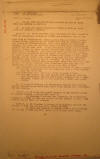
|
April 8, 1929.
"Report," Lt. Hanneken, La Pavona, p. 1.
"1. 2nd Lt. Kerr and
30 Marines reported in here at about 1700
from GARCIAL on April 5. ¶ 2.
Lt. Kerr and patrol cleared LA PAVONA at
0700 on April 6 for LOS ANGELES – GARCIAL.
¶ April 6 – 3. Lieut Hanneken with 8
Marines and Comm. Escamilla with 30
voluntarios cleared LA PAVONA and patrolled
area on the west side of CHACHAGON Mt. About
4 miles from LA PAVONA (Eulalio Flores
Finca), situated on the South West side of
CHAGHAGON are the Fincas of Gillermo Ribera,
José Maria Rivera and Florencio Cornejo, all
three of whom have been operating with
Altamirano as bandits for the past year. In
the immediate vicinity of Guillermo Rivera’s
finca, is where contact between Capt. Edson
and Altamirano took place on March 17. The
houses on both the Rivera’s fincas were
burned, apparently by Capt. Edson. The house
of Cornejo which is about 1 mile to the
South of Rivera’s was burned by the
undersigned, and all cattle were taken to my
Base for use. Destroyed everything that
could be used by bandits. In this vicinity
is where Altamirano crosses when going north
toward CUA and PASO REAL DE CUA. It is not
believed that Altamirano goes into the PENA
BLANCA MTS as they are barren. Returned to
Base at 1700. ¶ The following
natives reported in at LA PAVONA on April 5
and 6: ¶ (a) Ruperto Quintanilla
and son Fidel who have a finca between here
and GUASANARO. ¶ (b) Victoriano
Rios, who has a finca at upper PAVONA.
¶ (c) Guillermo Garcia, his sons
Miguel (23) Pantaleon (16) his wife
Estauislada Vasquez and 7 large daughters
and 6 small children. Garcia who is an
indian has a finca near upper PAVONA.
¶ 4. Lt. Paige 10 Marines and
Voluntarios with 10 days rations cleared
Corinto Finca about noon April 6 and camped
near CONSTANCIA for the evening. ¶
April 7. 5. Lt. Paige and patrol arrived at
SAN ANTONIO (Finca of Antonio Rivera) at
about 1000 April 7. ¶ Lt
Hanneken 8 Marines Gen. Escamilla 23
Voluntarios cleared LA PAVONA at 0700 and
arrived at SAN ANTONIO at 1800. Both patrols
camped there for evening. ¶
April 8. 6. Lt. Hanneken 8 Marines 20
Voluntarios cleared SAN ANTONIO at 0700 and
arrived at LA PAVONA at 0900. ¶
Lt. Paige and balance of command with
rations cleared SAN ANTONIO at 0800 and will
arrive at LA PAVONA about 1400. . . . "
|
|

|
April 8, 1929.
"Report," Lt. Hanneken, La Pavona, p. 2.
" . . . "This area is
[ illegible ] quiet at present. Inhabitants
are working in the Fincas, at least at the
present time. ¶ 8. Manual Matute, bandit
prisoner states that Altamirano crosses the
TUMA River near the house of one Cesario
Rivera about 2 or 3 miles North of Tuma,
using trail to JUAN PALACIO, “Hacienda
BONETILLA”. He goes through a coffee grove
near Rivera’s house, from there he goes
North into area LAS CUCHILLAS and either
cuts north or east there. ¶
LIEUT HANNEKEN ¶ Copy to Area
Comdr Northern Area. ¶ NOTE:
Have returned to LA PAVONA to base as there
is very poor water at SAN ANTONIO. ¶
Hanneken."
|
|
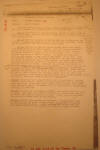
|
April 8, 1929.
"Patrol Report," Gunnery Sergeant William A.
Lee, Jinotega, p. 1.
"Cleared Jinotega
10:10 am with 8 Marines and 73 armed natives
for St. Fe. Arrived St. Fe 3:30 pm Feb. 5.
No information. ¶ Feb. 7:
Cleared St. Fe for San Antonio. Passed La
Lajas 11:30 am marked by planes. Arrived
5:30 pm. People here are Sandinistas. Show
dislike for us. ¶ Feb. 8: Camp
San Antonio 4 small patrols are looking over
the section. People are scared of us and do
not know anything. Found two US horses shot
one and taking other along. ¶
Feb. 9: Cleared San Antonio passed Marine
Graves and ambush 5 mi north on trail to
Monte Christo. Have two squads in brush as
flanks so am traveling slow. Found fresh
camp at Monte Christo. We crossed river Rio
Grande for mt top following trail. Bandits
cleared camp about 10 minutes before. We
fired on 4 that were left as rear guards as
they took to the brush. No one hit. They
scattered in a north and westernly
direction. We slip the force one going to
Rica Bajo other to Rico Rivas. No bandits
were found. We learned later they gathered
at a point 1/2 southwest of Rica Bajo and
went to La Pavona. Captured one of gang Ines
Chavarria he said Sandino was president of
this section. He had a food station for
bandits and is the whiz of the macer [juez
de mesta] by Sandino’s appointment he finds
the people and carries out orders given him.
Abram Centeno Sandino’s runner was at his
house on 7th he wouldn’t tell the purpose he
told us Pedro Blandon and Florencio Davila
were the ones that killed Marines at San
Antonio and that they have a little machine
gun and that they were going to kill all
white faces. ¶ Feb. 10: Camped
in Rico Rivas on Main trail to Constancia.
Patrols scouting this section. There is a
good trail from here to Pantasma south and
east. No bandits seen. Other patrol at Rica
Bajo burned Pedro Blandon’s house. No
bandits seen in that section. We finished
Chavarrias at 10:15 am. ¶ Feb.
11: Cleared for Constancia. Joined other
patrol from Rico Bajo at 10:30. All houses
vacated in Constancia on information went on
to Placo 3 mi south of Cocoa at St. Rita.
Runner came in with note bandits in La
Pavona north of San Antonio. ¶
Feb. 12: Scouted this section to the Cocoa.
There is good trail east of San Cruz and
other to Ochoa west. Sent runner to Quilali
no good information there. Heard one bomb
and machine gun fire from Planes south east
of Quilali. I thought it best to return . .
. "
|
|
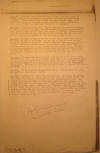
|
April 8, 1929.
"Patrol Report," Gunnery Sergeant William A.
Lee, Jinotega, p. 2.
" . . . [south on]
information. ¶ Feb. 13: Cleared
Placo for Rico Bajo. Burned the 15 houses of
Ismael Peralta and Florencio Davila two of
them had ammunition in them. Found bandit
camp within 200 yds of each house there must
have over 200 men here at one time less than
a month ago. I believe it was the gang that
turned in at Honduras. ¶ Feb.
14: Camped at Rico Rio. Planes dropped
information bandits in mts 10 mi north of
Yali 4:15 pm patrols returned found bandits
camp vacant 1 mi east of here Rio Bajo. I
believe Davila's house here is food station
for bandits he had on hand 300 lbs salt and
plenty of corn and coffee and has nothing to
say to us. ¶ Feb. 15: Cleared
for La Pavona one patrol going south east by
way of Monte Christo other south west by way
of Qualicia to meet in upper La Pavona at
12:30 pm. Bandits cleared town on our
arrival for mts north and west of town. We
follow them until 8:00 pm they scattered in
mts it was impossible to get contact. All
men in La Pavona are with them Jose Leon
Diaz is chief Pedro Blandon second they
about 50 men two machine guns and one st.
Rifles and ammunition. We cannot get a good
report on all say they are all armed.
¶ Feb. 16: We patrolled mts here for
distance of 5 mi in the brush. Bandits have
split and gone north. Jose Leon Diaz slept
house upper La Pavona Feb 11 guarded by 15
men and 2 machine guns Canco Monson is whiz
the Macer [juez de mesta] here appointed by
Sandino and is the only authority here. He
took to the brush on our arrival we burned
his house on 17th. ¶ Feb. 17: We
beat the brush around mts of La Pavona until
sun down no results. Bandits are north.
¶ Feb. 18: Cleared for Yali arrived
11:30 pm. Sir it is my opinion that this is
a bandit section the people here are aiding
them. We have moved all families to Yali and
San Rafael telling that the planes are going
to bomb and kill all that are left behind. I
am giving them two days to clear out. Then
am going back through there and clear house
right. Bandits work Pantasma, Quilali and
Points to the south and west from this area.
It is a high broken mountainous country own
and controlled by Sandino there are no Gov.
Officials here. All houses have families and
pay a bounty on their lives to bandits
gangs. Sandino is north of Cocoa River.
Signed: William A. Lee."
|
|
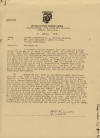
|
April 8, 1929.
"Voluntarios," 2nd Lt. M. L. Dawson, Ocotal,
to Col. Rossell, Ocotal.
"1. I assumed military
control over one half of General Caldera’s
column on or about 3 March, 1929, and
proceeded to Rempujon. This force consisted
of: Colonel Esguerro, Colonel Morales,
Captain Lopez and forty-seven enlisted
voluntarios. All these men were from teams
in the vicinity of Managua. The group of
voluntarios operating under me were lacking
in discipline, they were not versed in the
arts of military warfare, and they lacked
the health and stamina which are needed to
successfully conduct sustained operations in
the field. At this time they had been in the
field about one month and both officers and
men had lost the enthusiasm which marked the
first few weeks they were in the service of
the Nicaraguan Government. ¶ 2.
Before we had been in the Rempujon-Mina
California area two weeks they had lost all
interest in the campaign and were anxious to
return to their homes. Their morale was so
low that it was a common occurrence for the
officers to strike and beat their men in
order to obtain even reluctant obedience.
The troop commanders, Morales and Lopez,
were as much at fault as their men because
they often wrangled with their commanding
officer, Colonel Esguerro, and at times
refused to obey his orders. The attitude of
Morales and Lopez is clearly shown by the
fact that on the sixteen combat patrols
which I took out from the base camp, I was
accompanied once by Morales and twice by
Lopez. Esguerro did more than his share of
the patrolling and was always willing to go
out. One cannot imagine such conditions
existing in any modern military force and it
is needless to say that no force in which
such conditions do exist can successfully
carry on sustained operations against any
type of enemy. ¶ M. L. DAWSON."
|
|
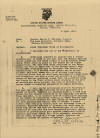
|
April 8, 1929.
"Armed Volunteer Force of Nicaraguans,"
Capt. George F. Stockes, Ocotal, to Col.
Rossell, Ocotal.
"1. I recommend the
use of the Voluntarios be discontinued.
¶ 2. Sufficient argument to justify
such a recommendation must be found in the
fact that the Guardia National should
constitute the armed forces of the
Nicaraguan Government. There seems no place
in the scheme for an orphan organization.
The same work being performed by the
Voluntarios can well be taken over by the
Guardia should they be increased
correspondingly in strength. The Guardia is
non-political. In a country where people are
so violent in their political views this is
of extreme importance. A military force with
at least some semblance of organization and
discipline, and with a clear cut mission is
one thing; groups of natives recruited
solely from one political party and thrown
in the field without basic training in the
arts of warfare are quite another. The task
of directing the latter class in sustained
patrolling is indeed difficult. ¶
3. I have served continuously with the
Voluntarios for over two months. The
territory we have patrolled is a matter of
record, likewise our accomplishments. I have
only praise for the stamina exhibited by the
majority time after time. However, in no
instance have we accomplished anything in
the nature of eliminating banditry in Nueva
Segovia that one-half or three-fourths the
same number of Marines could not have
accomplished equally well or better. I
cannot refrain from adding my opinion that
the Volunteer Force is partisan. Composed
entirely of Liberals who still seem to think
they are at war with the Conservatives, it
has been difficult at times for the Area
Commanders military representative to
prevent minor acts against inhabitants
holding opposite political views. This is an
unhealthy situation and one which in time
will foster hatred, distrust, and suspicion
instead of loyalty to country. ¶
GEO. F. STOCKES"
|
|
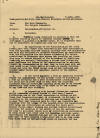
|
April 9, 1929.
"Voluntarios, efficiency of," 1st
Endorsement, Northern Area Commander Colonel
J. A. Rossell, Ocotal, p. 1.
"1. Forwarded. ¶
2. There is being submitted in connection
with the attached report, a report of
somewhat similar nature by Lieutenant M. L.
Dawson, U.S. Marine Corps. It is requested
that one be considered in connection with
the other. ¶ 3. My impressions
of the Voluntarios, as set forth herein,
have been formed from observation, and from
conversation with the American officers
dealing directly with the Voluntarios and
with the Voluntario’s officers themselves.
My conclusion is that the Voluntarios are
the finest inspiration for future
revolutions in Nicaragua that anyone can
possibly put forth. They hope to create
support of the Government by instilling
fear: they are actually developing a hatred
that ultimately must challenge the forces of
the administration to maintain itself. My
recommendation is that they be done away
with and that there be no future native
military, or partly military, forces put
into the field except such as are developed
and trained under direct and immediate
control of the Guardia National. ¶
4. In the first analysis I find no patriotic
motives behind the activities of the present
force of Voluntarios. I find an unhealthy
and a most objectionable principle, that the
party now in power must so deal with its
political opponents that, in future, the
opposing party, may be so reduced
numerically that there will be no doubt as
to the outcome of any free and fair
election. ¶ 5. In connection
with General Flores, the present native
commander of armed forces in this area, I
cannot disillusion him of the fixed
impression he betrays at all times that
Conservatives must be eliminated. He
delights in reverting to the surrender at
Tipitapa and stressing the alleged fact that
Liberals were in every way honorable and
complying with the terms of the compact
while the Conservatives were lying and
dishonorable in carrying out their part.
General Flores cannot discuss any subject
without intentionally injecting the question
on the merits of the two parties. His mind
is poisoned beyond hope of correction. In
conversation he heaps abuse upon abuse upon
the opposing political party individually
and collectively, and yet his acts which are
not made part of the attached letter, prove
him to be even worse than those whom he
castigates. He knows no superior but the . .
. "
|
|
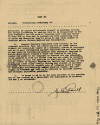
|
April 9, 1929.
"Voluntarios, efficiency of," 1st
Endorsement, Northern Area Commander Colonel
J. A. Rossell, Ocotal, p. 2.
" . .
. President. He cannot subordinate himself
to American control, and though professing
to realize that he is responsible to the
Area Commander for his acts, it requires
more time and effort to keep him in line and
to prevent him from committing acts of abuse
and deception than is given to any other
phrase of combined action between Marines
and Voluntarios. ¶ 6. General
Flores’s followers work entirely on the
personal equation. They can follow him but
no other leader without his consent. He
boasts of a wonderful system of espionage
set up to gain information against
Conservatives and when once he has received
information against such person, or imagines
he has, he constitutes himself a court and
decides to and does employ the force at his
disposal to execute his own judgment. In my
opinion he does not differ from any who
might be selected and willing to fill the
position he now occupies. His followers are,
as stated by Captain Stockes, the ragtail
and bob-tail of the Nicaraguan lower class
totally lacking any element of military or
other education, and capable only of
bringing about a reign of terror. His
motives always have an ulterior object. His
personnel is despised and held up to
ridicule by enlisted Guardia and civilian
population generally. ¶ 7. It
seems to me to be the best interest of the
Guardia, and of the country as a whole, that
the Voluntarios be mustered out and I so
recommend. ¶ J. A. ROSSELL."
|
|
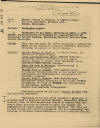
|
April 10, 1929.
"Conference Report," Capt. George F.
Stockes, Ocotal, to Col. Rossell, Ocotal, p.
1.
"1. Conference at Los
Manos, Honduras on April 6, 1929, between
representatives of Honduras and
representatives of Lieutenant Colonel
Rossell, Commanding Marines, Northern Area,
Western Nicaragua. ¶ OBJECT:
Seek ways and means for better cooperation
between the armed forces operating along the
frontier, Nicaragua-Honduras, in pursuit of
bandit groups. ¶ PRESENT:
Captain George F. Stockes, U.S. Marine
Corps, for Lieutenant Colonel Rossell.
¶ First Lieutenant John Hamas, Guardia
Nactional, Commanding Guardia detachment at
Los Manos. ¶ General Felipe F.
Flores, Jefe Voluntario group operating
under Captain Stockes. ¶ Señor Don José B.
Henrique, Sub-Secretary of Gobernacion of
Honduras. ¶ General José A.
Sanchez, Jefe Expeditionary, Honduran troops
operating on the border between Pedregalito
and Cifuentes with headquarters at Yuscaran,
Honduras. ¶ General José B. Mendoza, Jefe
Expeditionary, Honduran troops operating on
the border between Pedregalito and Gulf of
Fonseca with headquarters at San Marcos,
Honduras. ¶ Captain José
Espinoza, Interpreter. ¶
Conference opened at 1:50 p.m. Captain
Stockes made the following statement:
¶ ‘Gentlemen it is with great pleasure
I greet you, I am privileged to represent
Colonel Rossell, Commanding Officer,
Northern Area at this conference. Please be
assured that the Marine Corps has only one
motive in mind, the pursuit and elimination
of bandit groups along the frontier. With
this and in view we ask your active
cooperation. You are undoubtedly well
informed of existing bandit conditions in
the immediate vicinity. . . . "
|
|
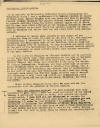
|
April 10, 1929.
"Conference Report," Capt. George F.
Stockes, Ocotal, to Col. Rossell, Ocotal, p.
2.
" . . . In my capacity
as Commanding Officer of troops accompanying
the Voluntario force I had a conference with
General Mendoza at Espino on March 24th.
Carlos Salgado with his group was then in
Honduras, located between Calpules and
Duyure. General Mendoza and I agreed to
operate actively along the border between
Espino and El Poste, and to keep each other
informed of the changing situation. General
Mendoza assured me he would fight the
bandits whenever he found them in Honduras
and follow them day and night after once
gaining contact. ¶ I returned to
Somoto well pleased at the result of our
conference. Here at last, at least on the
face of it, was complete understanding. I
determined to leave Somoto at once, to
patrol thoroughly the Nicaraguan side of the
frontier, and, in case the bandits crossed
over to Honduras, to camp opposite and await
action on the part of the Honduran troops. I
had assured General Mendoza that if
necessary we could operate ninety days
without returning to our home station.
¶ As far north as Calpules we (General
Mendoza and I) operated as had been agreed
upon. Here cooperation on the part of
Honduras ceased. Why? The campaign was just
beginning, and Salgado, as General Mendoza
well knew, had retreated North along the
border. He entered Pedregalito, Honduras,
and then moved east in Honduran Territory
until he effected a junction with Ortez,
who, I am in a position to truthfully say
without fear of contradiction on the part of
any one, had established himself near Los
Limas, Honduras. Here along the frontier
Ortez received untold support from Honduras.
I will later lay before you indisputable
proof that he has lived off and on in Los
Manos, Honduras, for over one month. ¶
Since leaving Calpules March 28th. we have
awaited the cooperation that was promised by
General Mendoza. ¶ Señor Don
Henrique replied: ‘I have listened
with much attention to your talk. I know the
great government of the United States, a
government founded on truth, is a sincere
and honest establishment. I also know you
are determined to capture the bandits or
drive them out. At the same time the
campaign you are conducting – I refer to
your aviators – is destructive. The
Government of Honduras – the government of
Doctor Mejia Colindres, wanted to cooperate;
at the same time we want a frank
understanding of your policy and your
intentions. I want to lay before Colonel
Rossell the fact that we stand ready to
defend our frontier against invasion. . . .
"
|
|
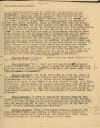
|
April 10, 1929.
"Conference Report," Capt. George F.
Stockes, Ocotal, to Col. Rossell, Ocotal, p.
3.
" . . . We are sincere
guardians of our frontier. We are proud of
our sovereignty. We stand ready to guard our
frontier against any bandit group which may
inflict damage. (Here Captain Stockes
interrupted interpreter, Captain Espinoza
and had him repeat the 1st part – 'inflict
damage'). On the 31st of March the aviators
bombed Los Limas, Honduras, which is located
very near the border, across from Brujil.
The damage insofar as pertains to material
was not great; one small house was destroyed
along with two coffee places. One bomb
failed to explode. You can see it now if you
visit that place. I want to ask that the
work of eliminating bandits be conducted
without the use of airplanes. I request that
the Air Service do not operate on the
frontier. (Here Don José gives names of
persons whose property was affected.) I have
no complaint against your patrols, only
against the Air Service. We must with great
zeal guard our frontier. I am sorry you
accuse individuals and repeat the actual
Government of Doctor Mejia Colindres is
frank and sincere. Perhaps there are
individuals in Honduras who aid Sandino; the
Government does not. From today on a
different situation will exist, for Generals
Sanchez and Mendoza are charged by me with
disarming all groups who penetrate and
inflict damage in Honduras.' ¶
Captain Stockes talking: 'Were there
any people killed in the air attack you have
cited?' ¶ Señor Henrique:
'No. I might say that my principal complaint
against the Air Corps is the fright
occasioned upon their approach. Their
appearance prevents people from carrying out
their daily work. They are afraid of
airplanes.' ¶ Captain Stockes:
I am sorry that I cannot shed any light on
the airplane incident at Los Limas. I know
nothing whatever of the circumstances. On
that date my column was at Pedregulito, some
fifteen miles west of Los Limas. I am sure
Colonel Rossell will fully investigate.
Perhaps there are mistakes occasionally made
relative the boundary line. As far as my
column, which includes the Voluntarios, is
concerned, I can assure you that not one
shot has been fired on Honduran territory,
nor have any inhabitants of your country
been molested.' ¶ Señor
Henirque: 'I have no complaints
whatever against foot troops. General
Mendoza has told me of your reputation for
honesty, but I must again request you to
better control the aviators in order that
our people may not be unduly excited and
that we may work in peace. We must zealously
guard our frontier.' ¶ Captain
Stockes: 'Talk is one thing; action is
another. The Area Commander seeks real
action. I refer you to the letter of
instructions Doctor Mejia Colindres, your
President, after taking office, addressed to
the Jefe of troops of this zone. . . . "
|
|
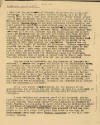
|
April 10, 1929.
"Conference Report," Capt. George F.
Stockes, Ocotal, to Col. Rossell, Ocotal, p.
4.
": . . . I feel that
the government of Honduras is sincere and I
ask your indulgence, if I seem to convey
another meaning, as I do not so intend. That
is why I have just mentioned the letter
issued personally by your President. Have
those instructions been complied with:
Pending contradiction I answer the question
in the negative. Did he not charge General
Reina to not only eliminate active bandits,
but their agents as well? Was a real attempt
made to do this? I believe I recall one
paragraph in which he specifically directed
certain border villages be closely watched.
Danili, Paraiso and Suyatal were mentioned
if I am not mistaken. You say bandit groups
who inflict damage in Honduras will be
attached and driven out. Your frontier is a
hot bed of propaganda, and a hiding place in
emergency for bandits. A cut-throat or a
fugitive from justice must always seek some
haven of refuge and when he is located it is
hardly to be expected he will turn against
his benefactor. Honduras has not suffered as
a result of banditry in Nicaragua. Without
appearing boastful let me add, I know the
frontier from Cinco Pinos to San Pablo, in
fact I know every yard of that frontier –
250 miles, more or less, probably more by
trail on the Nicaraguan side. If you could
see the waste and desolation along the
Nicaraguan frontier perhaps then we would be
better able to follow each other. From Oyote
to Las Manos what have we? Why go into
details? ¶ Are you able to
truthfully say the frontier of Honduras has
suffered? I admire and respect the thrift of
the Hondurans along the border. If this
apparent prosperity is at the expense of
your sister Republic, what then? You infer
that your government is not responsible for
the acts of private citizens. I submit that
when that citizen is an official of the
government nothing could be farther from the
truth. To quote you 'Governments are in the
majority based on frankness and sincerity'.
I add there are two roads and governments
like individuals, may choose either; the one
of honesty, and the other the one of
treachery, deception and baseness, which
springs from the machinery of the brain.
¶ As we must assume responsibility for
the actions of our subordinates, our
patrols, our air service, so must the
government of Honduras assume the
responsibility for the acts of their border
officials. ¶ I have definite and
concrete proof of aid rendered, shelter
furnished, etc., to the Ortez and Salgado
groups by border officials of your country.
What about Ortez? A real influence in
banditry in Neuva Segovia. Are you going to
again permit him to live in Los Manos at the
house of Alexandro Valladarez as he did
during part of last month? We now know that
during this time one-half of his men were
camped on the hill about 2000 yards from
where we now are, in Honduras; the other
half under Ferboni Valquedano on the hill
overlooking Suyatal. . . . "
|
|
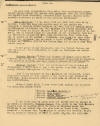
|
April 10, 1929.
"Conference Report," Capt. George F.
Stockes, Ocotal, to Col. Rossell, Ocotal, p.
5.
" . . . We seek real
cooperation. Time after time Marines have
chased bandit groups across the border into
Honduras. With our withdrawal the bandits
have invariably returned. (Here Captain
Stockes cites specific incidents of which he
has personal knowledge.) ¶ Señor
Henrique: 'I am sorry that you feel they
hide in my country. There has been
propaganda. Many of our people are ignorant.
I promise active cooperation, but, the Air
Service should be withdrawn. An aviator may
well mistake the actual frontier. The damage
in money is slight in most cases. In the
case cited it is very small, but my people
along the frontier do not understand that
the Air Service is acquainted with real
conditions. They think they may be bombed at
any moment, therefore, are afraid to show
themselves when airplanes can be heard. I
again repeat that Generals Sanchez and
Mendoza will in the future keep the frontier
free from bandit groups. ¶ We
are proud of our friendship with the United
States, and with Nicaragua. This friendship
is based on frankness and understanding.
¶ Captain Stockes: '(Cited the history
of Marine Corps activities in Nicaragua: the
Sandinista propaganda circulated in
Honduras, the apparent dislike, for some
unknown reason, of the 'gringos'). ¶
General Sanchez: 'With the permission of the
Minister of Gobernacion I would like to say
a few words. I am Jefe Expeditionary between
Pedregalito and the North. ¶ When I was
assigned to this position the President,
Doctor Colindres charged me with disarming
all bandits that entered my territory. Since
assuming office I have made an effort to
carry out his instructions. ¶ Since 5 March
1929, I have taken into custody and disarmed
the following bandit Jefes: ¶
General Porfirio Sanchez H. ¶
General Jose Lagos. ¶ Colonel Rufino
Ramirez. ¶ Colonel Pastor
Ramirez. ¶ I was taken sick on
March 15th and turned over my column to my
second in command, Colonel Flores. I am
sorry to say that he made reports that no
bandits could be found in Honduras along the
frontier. I was called from the sick list on
March 21st., having received a telegram from
Teguoigalpa to pursue the bandits. So you
see my campaign actually started on April
1st, only six days ago. . . . "
|
|
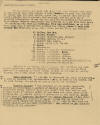
|
April 10, 1929.
"Conference Report," Capt. George F.
Stockes, Ocotal, to Col. Rossell, Ocotal, p.
6.
" . . . On the morning
of April 1st. I learned that Salgado with
about 50 men was in camp near Alauca. I left
Yuscaran at once with 100 men to attack him.
The next morning April 2nd, I learned from
one of my agents Salgado had disbanded, but
seemingly not for good for I received
information he had hid his arms and
ammunition in the mountains nearby. Further
information was received by a spy that this
cache of munitions was near Los Partidas.
This was confirmed, so at 9:30 a.m. April
3rd, I arrived and located the hiding place.
I took into custody the following arms,
etc., which are now in my possession:
¶ 15 Rifles, Con Con. ¶ 4
Rifles, Mauser ¶ 12 Rifles,
Springfields. (Krags) ¶ 9
Rifles, Enfume. (7M) ¶ 1 Machine
Gun, Lewis. ¶ 7 Drums, Lewis M.
G. Filled. ¶ 27 Bombs. ¶
46 Detonators. ¶ 27 Sacks for
carrying cartridges. ¶ 398
Rounds, Ammunition, Krag. ¶ 58
Rounds, Ammunition, Mauser ¶ 11
Rounds, Ammunition, Enfume. ¶ 80
Rounds, Ammunition, Con Con. ¶
850 Rounds, Ammunition, Springfield, Caliber
30. ¶ A large quantity of
dynamite. ¶ Salgado is in
hiding. He is through with banditry. The
last report placed him near El Perecol,
Honduras. His men are drifting back to the
vicinity of their homes. We will be bothered
no more by Salgado, and I will chase Ortez
from Honduras. ¶ Señor Henrique:
'A man may be denounced and still be
innocent. I hate to believe that Hondurans
living so near to the border, and to your
forces, are guilty of giving aid to the
bandits.' ¶ Captain Stockes:
'The practice of one person denouncing
another is undoubtedly a product of Central
American politics. Lieutenant Hamas, General
Flores and myself will turn over to you
certain names of persons living in Los Manos
and other sections of Honduras who we
believe guilty of giving aid to the bandits.
Except in the case of Alexandro Valladarez
and Gavino Gallindo of Los Manos I am
personally not positive of guilt. I feel the
two named are without doubt really and truly
guilty. At any rate we turn over the entire
list to you for such investigation and
action as you consider advisable in the
premises. . . . "
|
|
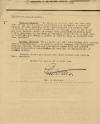
|
April 10, 1929.
"Conference Report," Capt. George F.
Stockes, Ocotal, to Col. Rossell, Ocotal, p.
7.
" . . . General
Mendoza: 'It seems to me that what has
been said here today is of extreme
importance and should be a matter of record.
General Sanchez, after April 1st, was the
ranking Jefe of forces. My government placed
him in charge. That is why I did not come
further north. We should feel gratified at
having such a fine companion as the Jefe of
Marines, whose men it is said live on
tortillas and beans. I pledge my word to
keep my district free from bandits.' ¶
Captain Stockes: 'It is hoped our talk
here today will produce better
understanding. We want to work in harmony
with Honduran patrols. General Flores and
Lieutenant Hamas will now present certain
information relative people residing in
Honduras who we believe guilty. ¶
General Flores and Lieutenant Hamas turned
over list to Señor Henrique. ¶
Conference adjourned at 4:00 p.m. ¶
GEO. F. STOCKES."
|
|
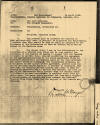
|
April 10, 1929.
"Voluntarios, efficiency of," 3rd
Endorsement, Jefe Director General D. C.
McDougal.
"1. Returned, contents
noted. ¶ 2. The present plan to
increase the Guardia to 2200 enlisted will
make it possible to eliminate the
Voluntarios. I believe that this should be
done as early as possible by the discharge
of the Voluntarios as fast as Guardia units
can be placed in the Northern Area. ¶
3. The danger which I see in the Voluntarios
is the formation of a Liberal army which can
be used against the interests in the Guardia
by making it appear that the Guardia is
unable to do this duty, thereby nullifying
the paragraph in the Agreement submitted by
the State Department which in substance
states that the Guardia shall be the sole
military and police force in Nicaragua. The
Voluntarios presence, as a violation of the
spirit of the Agreement, permits also the
use of Hacienda Guards which it is desired
to eliminate. The fact that the Voluntarios
are Liberal and prone to make reprisals on
Conservatives is another bad feature. The
rate of pay of the Voluntarios being greater
than the Guardia makes it difficult to make
enlistments in sections where they operate.
Also, the money being expended for them
would support a larger number of Guardia and
also reduces the National Treasury from
which funds for the support of the Guardia
are obtained. ¶ D. C. McDOUGAL."
|
|
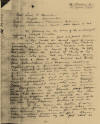
|
April 11, 1929.
"Volunteers — Escamilla's Column," Lt. H.
Hanneken, La Pavona, to Brigade Commander,
p. 1. "Reference:
Letter Brigade Comdr. Dated April 10, 1929
¶ 1. The following are the views of
the undersigned regarding subject matter.
¶ (a) Their value in past and present
operations. ¶ It has created the
desired effect of ‘morale in numbers’, which
apparently has been lacking previously; in
the past the bandits who were generally
together in bands of thirty to fifty did not
fear the patrols of thirty or so Marines who
were out in various areas, but with a force
of one hundred and twenty five Voluntarios
and Marines moving together, giving
formidable appearance, it has created a
state of fear in the supporters of the
bandits, and also in the small bands, of
being surrounded and wiped out; and has
caused them to quit or to keep moving. From
information obtained from Andres Lopez, the
bandit spy, who was executed in Onconguas,
it appeared that the presence of our force
in the Chipote and Oconguas Areas has caused
the natives who had been furnishing supplies
to the bandits in the vicinity of those
areas to get out and to go the San Juan de
Telepaneca district to report in. ¶
It has caused the capture of more spies and
prisoners, who carried along in our column
gave cause for fear to any other native
supporters or spies. These captures being
caused by the fact that as . . . "
|
|
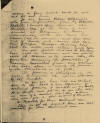
|
April 11, 1929.
"Volunteers — Escamilla's Column," Lt. H.
Hanneken, La Pavona, to Brigade Commander,
p. 2.
" . . . many as four
patrols could be sent out at one time.
¶ It has caused Pedron Altamirano, who
from information given by Manuel Matute
(bandit Spy), was in the Bentilla Mts. at
the time of our arrival at Oconguas, to
leave immediately with his band, his women
(six in number), and two sons and go South
into areas that have been peaceful
heretofore. It is my belief that he will not
return north again. ¶ In all
patrols sent out the Voluntarios have acted
as advance and rear guards with the Marines
as the main body; this formation decreasing
the possibilities of Marine casualties from
any ambush. (This value alone is worth the
presence of the Voluntarios in the field.)
¶ The presence of Voluntarios in the
field diminishes the ration allowance of the
bandits. ¶ So far we have had no
contact due to the lack of any opposition or
continued presence of bandits in any
locality. It is therefore not possible to
give this value in case of a contact, but I
am certain they will give a good account of
themselves. ¶ (b) Necessity of
their continued use. ¶ There is
at the present time no real necessity for
their continued use. . . . "
|
|
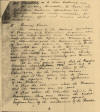
|
April 11, 1929.
"Volunteers — Escamilla's Column," Lt. H.
Hanneken, La Pavona, to Brigade Commander,
p. 3.
" . . . (c)
Desirability as to their continued use.
¶ It is very desirable to have the
Volunteers continue operations in the field
for several more months, for its morale
effect and reasons stated under (a). ¶
2. General Views. ¶ The success
of the combined operations of Marines and
Volunteers requires above all the whole
hearted and harmonious cooperation of the
officer in command of the Volunteers with
the Commanding Officer of Marines. All
orders or commands to the Volunteers are
given to the Commanding Officer thereof. The
campsite of Marines and Volunteers are kept
separate thereby abolishing any racial
enmity and causing less opportunity for
friction. ¶ It is my earnest
belief that the Guardia Nacional should be
sent out to operate with Marines in place of
the Voluntarios, for the following reasons:
¶ 1) That it has given rise to fears
in the populace as to the effectiveness of
the Guardia. ¶ 2) That the
Volunteers state the Guardia and its members
are no good. ¶ 3) That when the
Volunteers return to Managua they will claim
the credit for stopping banditry and spread
information of the uselessness of the
Guardia. . . . "
|
|

|
April 11, 1929.
"Volunteers — Escamilla's Column," Lt. H.
Hanneken, La Pavona, to Brigade Commander,
p. 4.
" . . . 4) That the
reason that the Guardia is not trained and
should be well trained before taking the
field is in error, because the Voluntarios
are not trained and are doing their work. It
is well to have them trained, but it is
better for its moral effect on the
population to have the Guardia out in the
field untrained in place of the Voluntarios
than to have the Guardia trained and then
find no necessity for their use in the field
because the bandit situation has been
cleared with the help of the Voluntarios.
¶ 5) The volunteers, who are all
Liberals, are prejudiced against the
Conservatives. ¶ H. H. Hanneken"
|
|
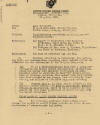
|
April 12, 1929.
"Unsatisfactory conditions on
Nicaraguan-Honduran border," Northern Area
Commander Colonel J. A. Rossell to Brigade
Commander, p. 1.
" . . . Reference: (a)
Report of Conference with Honduran
officials, dated April 10, 1929, by Capt. C.
F. Stockes, U.S.M.C. ¶ (b)
Telegram of Gen. José A. Sanchez,
Expeditionary Chief of Yuscaran, Honduras.
¶ Enclosures: (2) Copy of reference
(a) and (b). ¶ 1. Inviting attention
to enclosures, the following facts and
circumstances regarding above subject matter
are submitted for the information of the
Brigade Commander: ¶ (a) It is a
well-established fact that a large
percentage of the bandit forces now
operating in Nicaragua cross the border into
Honduras practically at will. Positive proof
is available to show that bandit groups have
on numerous occasions filed across into that
country when hard pressed by our troops,
thus effectively frustrating our efforts to
eliminate organized outlawry. ¶
(b) General José A. Sanchez, senior officer
of the Honduran border patrol, and Juan B.
Henriquez, Sub-Secretario de Gobernacion,
leave it to be inferred in reference (b)
that their government is unable to cope with
the border situation. ¶
KNOWN CASES OF BANDIT
GROUPS CROSSING BORDER ¶
2. The following instances where outlaw
forces crossed the border to escape Marine
patrols are cited in substantiation of
sub-paragraph (a) above: . . . "
|
|
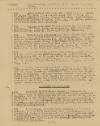
|
April 12, 1929.
"Unsatisfactory conditions on
Nicaraguan-Honduran border," Northern Area
Commander Colonel J. A. Rossell to Brigade
Commander, p. 2.
" . . . (a) After
contact with a Marine patrol at Las Palancas
on August 17, 1928, Ortez and Maldonado with
about 40 men fled into Honduras, passing
through Calpules. They remained in Honduras,
between Calpules, Nicaragua, and Duyure,
Honduras, until the Marines were withdrawn.
¶ (b) Salgado with about 75 men
crossed the border into Honduras, near Santa
Emilia on October 25, 1928, to escape Marine
patrols under Lt. Cartwright and Lt.
Schubert. ¶ (c) Both Salgado and
Ortez with their forces fled into Honduras
to escape the Stockes-Caldera column which
operated in Northwestern Segovia Feb. 4th to
12th, 1929. Both bandit groups passed
through Pedregalito, Honduras, informing the
Commandant there that they were going to [?]
to seek amnesty. The Commandant of Arms,
Alauca, Honduras, was so informed by the
local Commandant of Pedregalito. ¶
(d) When trapped by patrols from Somoto,
Pueblo Nuevo, San Juan de Limay and
Somotillo, Salgado crossed the border into
Honduras West of El Angel, on or about 15
March, 1929. He then moved North, using
Honduras territory most of the way, and
established himself between Calpules and
Duyure, on Honduran soil. ¶ (e)
During the recent combined military
operations in Northwestern Segovia, both
Salgado and Ortez crossed the border with
their forces and established themselves West
of Las Manos, in Honduras. With our various
columns camped on the border opposite the
bandit groups, and after repeated requests
on Honduran officials for appropriate
action, Salgado’s men were recovered from a
cache where they have been hidden. All
bandit forces escaped. ¶ 3.
PERTINENT
CIRCUMSTANCES. ¶ (a)
President Colindres has refused permission
for Marine patrols to enter the disputed
territory in pursuit of bandits. This is
considered one of the problem hiding places
of Sandino at the present time. Unconfirmed
information is to the effect that the
political record of President Colindres, as
well as that of some of his cabinet members,
has been consistently anti-American. ¶
(b) Information, received confidentially but
believed reliable, is available indicating
that controlling members of the Liberal
Party of Honduras entered into agreement
with Sandino prior to the last election in
that country, regarding a projected
revolution in case the Liberals (Honduras)
were defeated at the polls. . . . "
|
|
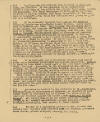
|
April 12, 1929.
"Unsatisfactory conditions on
Nicaraguan-Honduran border," Northern Area
Commander Colonel J. A. Rossell to Brigade
Commander, p. 3. "
. . . "(c) Honduras has not suffered from
banditry in Nicaragua along her frontier. To
the contrary, it is persistently reported
that many of the outlaws who plunder
Nicaraguan property are Hondurans. The local
Commandant of Pedregalito, Honduras,
admitted to Captain Stockes that about
four-fifths of the members of Salgado’s
group which was disbanded near Alauca on
April 1st were Hondurans. ¶ (d)
It is variously reported that many of the
Honduran border officials are sympathetic
toward Sandino. Known facts tend of
substantiate this. Gen. Mendoza,
Expeditionary Chief of San Marcos, who
commands the border from Pedregalito to the
Gulf of Fonesca, admits an old friendship
with Salgado. Gen. José A. Sanchez,
Expeditionary Chief of Yuscaran who commands
the border patrol from Pedregalito to
Cifuentes, is declared by responsible
persons to be a cousin of Porfirio Sanchez,
Ex-Chief-of-Staff to Sandino. It may be said
that Gen. Sanchez is, ostensibly,
endeavoring to cooperate at the present
time. However, it is known that Ortez lived
for approximately one month, prior to April
6, 1929, in the house of Alejandro
Vallodarez in Las Manos. The same Vallodarez
is now reported on good authority to be
under the alias of Ramon Rodriguez, serving
as an officer of the Honduran border patrol
under Gen. Mendoza. Vallodarez is also the
employer of Sabino Galindo, a known agent
for Ortez in Las Manos. ¶ (e) It
is variously and persistently declared that
bandit jefes enter Honduras on missions for
Sandino unmolested. Quesada is known to have
spent a large part of the past three months
in Danli, Honduras. According to the
statement of Gen. José A. Sanchez, the
bandit jefes, Porfirio Sanchez, José Lagos,
Rufino Ramirez and Pastor Ramirez recently
entered Honduras and were granted amnesty.
Porfirio Sanchez is quoted as saying that he
will return to Sandino as soon as he has a
rest and collects a supply of ammunition. No
known action has been taken by Honduran
officials against Ramon Raudales, bandit
supply agent at Danli, nor against the
German, Rossner, of Tegucigalpa and Danli,
who purchased the gold which Sandino looted
from the mines in the Pis Pis area. ¶
(f) Attention is invited to the statement of
Sr. Henriquez, Sub-Secretario de Gobernacion
of Honduras, as reported on page number
three of reference (a) as follows: ‘we stand
ready to guard our frontier against any
bandit group which may inflict damage’. All
information is to the effect that the bandit
groups do not commit depredations against
Honduran property because, inferentially,
that country is their asylum. ¶
(g) Whether as a diplomatic gesture or not,
various complaints have recently been
received from the Honduran government about
Marine patrols allegedly crossing the
border. . . . "
|
|
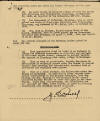
|
April 12, 1929.
"Unsatisfactory conditions on
Nicaraguan-Honduran border," Northern Area
Commander Colonel J. A. Rossell to Brigade
Commander, p. 4.
" . . . The following
facts are cited for future reference in this
particular: ¶ (1) An armed
patrol of Honduran troops crossed the border
into Nicaragua near Totecasinte, Nicaragua,
on September 22, 1928, as reported by the
Commanding officer, Jalapa. ¶
(2) The Commandant of Cifuentes, Honduras,
with an armed patrol was found on Nicaraguan
territory near Totecasinte, Nicaragua, and
disarmed by Lt. Davis, G.N., on October 21,
1928. ¶ (3) Gen. José B.
Mendoza, Expeditionary Chief of San Marcos,
Honduras, with an armed patrol was on
Nicaraguan territory near Pedregalito, on
April 7, 1929. This was reported by Lt.
Hakala. ¶ (h) The present
strength of the Honduran border patrol is
about 230 men. ¶
RECOMMENDATIONS
¶ (a) That appropriate steps be taken
in an endeavor to induce the Honduran
government to establish and maintain an
efficient border patrol, adequate to prevent
bandits who operate in Nicaragua from taking
refuge in Honduras. ¶ (b) That
as soon as practicable, Guardia Garrisons be
established at strategic points along the
border to prevent bandits from crossing the
international boundary line at convenient
and regularly used places. ¶ (c)
That as a local measure, the Voluntarios
under Gen. Flores be disbanded. In addition
to other reasons heretofore communicated to
the Brigade Commander, both Gen. Mendoza and
Gen. Sanchez of the Honduran border patrol
permitted Captain Stockes to infer that they
do not trust Flores. Under such
circumstances, the Voluntarios are not and
have not been, under Flores, an asset in
securing cooperation with Honduran border
officials. ¶ J.A. ROSSELL"
|
|
_small.jpg)
|
April 12, 1929.
"Perseguido de
Cerca," La Tribuna (Managua).
"El rebelde José León
Díaz que tuvo que salir de Yalí, huyendo de
la persecución de las tropas del
general Plata,
se halla, según noticias obtenidas por el
gobierno, en una hacienda cercana a
Jinotega; ya se hizo salir a una patrulla de
hombres de aquella cabecera a perseguirlo.
¶ EN DIPILTO ¶ El
general Felipe
T. Flores salió antier de
Ocotal para Dipilto con un regular número de
tropas a realizar una inspección general en
la vecindades del mencionado lugar."
|
|
_small.jpg)
|
April 14, 1929.
"Por el Gral.
Flores," La Tribuna (Managua).
"El
General Felipe
T. Flores, que salió antier
de Ococtal con dirección a Dipilto, capturó
en el camino a 16 hombres, 8 armados con
machetes y 8 con rifles. Pertenecían a la
columna del rebel de Ortez, y dos de ellos
formaban parte del grupo de 4 que dieron
muerte al Juez local de Dipilto,
Anastasio
Zamora."
Notes & Comments:
On the life & death of Anastasio Zamora in
Dipilto, see the
TOP
100 PAGE 34 and the
prison testimonies of the notorious
Conservative Chamorrista gang leaders
Anastasio Hernández and José Eulalio Torres,
in
GANGS.
There was something very convoluted going on
here. It seems entirely possible that Zamora
was killed by men operating under
Flores. The report claims that the 16 men
"captured" by Flores were the subgroup of EDSN
General Miguel Angel Ortéz that had killed
Zamora, a claim that in the end seems highly
dubious.
|
|
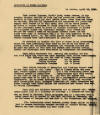
|
April 15, 1929.
"Statement of Jesus Vasquez," Lt. H.
Hanneken, p. 1. "That
Santos Vasquez, bandit jefe, under Pedron,
is his cousin; Nicolas Davilla is Jefe Spy
and provision provider for bandits in that
area; and that Davila moves about from one
Finca to another, obtains all information
and organizes the provision supply when
Pedron is in this area. That Pedron often
passes by home of Santos Vasquez to Sixto
Gutierrez house at La Pita to his (Vasquez)
house to house of Basilio Contreras to
fincas of Guillermo Rivera and Florensio
Cornejo. That Pedron was camped for about a
week at Guillermo Rivera's finca (on the
southwest side of Chachagon Mts.) at the
time previous to the Edson contact (Note:
All the above places with the exception of
Santos Vasquez have been destroyed by
patrols). ¶ He verified as
bandits the list of names in my possession,
which has been previously been sent in and
added the names of Isabel Roche and
Filiberto Hernandez and Transito Vasquez who
he said was spies in this area and worked
with Nicolas Davila. (Roche and Hernandez
have been tried by Volunteers and executed).
¶ That Julio Guatemala has several men
working for him and the Julio and those men
work together with Pedron occasionally.
¶ The following are the sons of Jesus
Vasquez: ¶ Andreas Vasquez Age
25 years. ¶ Julian Vasquez Age
20 Years. ¶ Bonafacio Vasquez
Age 8 Years. ¶ That Felipe
Machado of Matagalpa and Jinotega turned
over to one Juan Rial at Rial Finca near La
Virgen about one year ago, two rifles
(Springfields) with a box containing about
one thousand rounds of ammunition and
instructions that Rial would be the Jefe in
the La Virgen Area and that the rifles and
ammunition were to be held by him for a
contemplated revolution of Chamorro’s. On or
about February 1st, 1929, Juan Rial together
with Ermenejildo Rial, Epifanio Hernandez
and Felix Hernandez and Jesus Vasquez took
these rifles and ammunition and turned them
over to Pedron Altamirano. ¶
Juan Rial and Epifanio Hernandez are at
present with Pedron. Ermanejildo Rial is a
prisoner at Jinotega (I understand that he
was captured by Marines). Felix Hernandez
who is a deserter from a ranch guard and is
wanted by the Jefe Politico of Jinotega, was
at the house of Vasquez and was shot by the
Volunteers but escaped. ¶ (This
information about Machado giving those
rifles to Juan Rial is common knowledge
amongst natives as Eulalio Flores, Manual
Matute and Jefe Politicio all knew about
it.) . . . "
|
|

|
April 15, 1929.
"Statement of Jesus Vasquez," Lt. H.
Hanneken, p. 2.
" . . . Jesus Vasquez
will be tried by Volunteer Court Martial. ¶
H. HANNEKEN. ¶ Copy to Area
Commander, Northern Area."
|
|
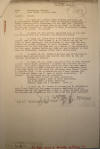
|
April 15, 1929.
"Report," Lt. H. H. Hanneken, La Pavona.
" . . . 1. On April 11
a patrol under
General Escamilla and 30
voluntarios burned down the house of
Sebastian Montenegro, a bandit operating
with Altamirano for the past year; gathered
up all his cattle and brought them to our
Base, to be used by Marines and Voluntarios.
Montenegro’s Finca is situated 2 miles north
of La Pavona. No contact. ¶ 2.
On April 12, two patrols patrolled area to
the west and south of here and returned,
reporting no contact. ¶ 3. On
April 13, Lieut. Paige 8 Marines and 25
Voluntarios cleared based at 0700 with
orders to go to La Pita and spy on house of
Sixto Gutierrez, and afterwards to burn same
and confiscate all cattle belonging to Sixto
Gutierrez. The house of Gutierrez at La Pita
has been used as a center of any activities
for this area. Nicolas Davila spy jefe and
quartermaster in this area for Altamirano,
lounged around there occasionally . ¶
4. On April 13, Lt. Jordan 8 Marines and 25
Voluntarios cleared Base and patrolled area
towards Paso Real du Cua and returned
reporting no contact. ¶ 5. On
April 14, Lt. Paige and patrol from La Pita
returned at 1400 with 3 women prisoners 7
children and reported the following: That
after spying upon house for about one hour
patrol approached house and made prisoners
of all the occupants; after a thorough
search of the house the following were
found: 1 bomb, 10 dynamite caps, 5 rds of
ammunition and 1 hand grenade (US). The
house was burned and 20 head of cattle
confiscated. No contact. The following are
the prisoners: ¶ Maxima Cano,
mother of Sixto Gutierrez. ¶
Nicolasa Coruijo, wife if Sixto Gutierrez,
and 2 children of Sixto Gutierrez. ¶
Factina Lopez and 2 children. Total 13.
¶ 6. On April 15, Lt. Jordan 11
Marines and 30 Voluntarios with a pack train
and the woman prisoners mentioned in par. 6.
cleared Base at 0630 for Corinto Finca to
obtain 12 days rations for Marines and
Voluntarios and to turn over the above
prisoners. ¶ H. HANNEKEN. 1st
Lt. USMC. ¶ Copy for : CO.
Northern Area."
|
|
_small.JPG)
|
April 15, 1929.
"Memo for Area Commanders, Northern &
Southern Areas," Lt. H. H. Hanneken, La
Pavona.
" . . . Reference:
Letter Brigade dated April 13-19 re
Altamirano ¶ 1. Above reference received on
April 14 and wish to report as follows:
¶ (a) This latest information received
regarding Altamirano was from the Jefe
Politico of Jinotega, dated April 13, in
which he states that the Marines had a
contact with Altamirano somewhere between
this town and Carretera; that Altamirano
recrossed the Tuma and [headed] south again.
That a prisoner of the bandits escaped and
[came] in at Jinotega. ¶ (b)
There is no information in this area as to
Altamirano’s whereabouts at present. The
natives are using main trails between here
and Jinotega. I have spies at the CUCHILLAS,
LA VIRGEN and CHACHAGON MTS, who are to
report here immediately in case Pedron
arrives. ¶ (c) Upon receipt of
some definite information will proceed
against Altamirano. ¶ (d) Upon
reporting of Lt. Jordan with rations from
CORINTO FINCA, will have rations up on May
1st. ¶ (e) The Jefe Politico of
JINOTEGA has been sending runners with
messages, giving the latest information, the
latest Nicaraguan newspapers to
General
Escamilla, about every other day since our
arrival here. This has been helpful and is
commendable. ¶ Lt. Hanneken."
|
|
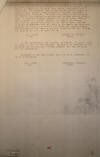
|
April 15, 1929.
Capture & Charges Against Isabel Rocha,
Voluntario General Juan Escamilla, et al.,
Encampment San Lorenzo, La Pavona, Jinotega
(English translation only), p. 1.
"At the encampment San
Lorenzo, La Pavona, 15 April, 1929, at seven
o’clock in the evening. I took the prisoner
to my office and asked him his name, age,
state, information and residence. He
answered that he was called Isabel Rocha, 30
years of age, married, day-laborer, living
at Tiosintal, department of Jinotega. On
asking him what he was doing at the time of
his capture he stated that he was working on
his farm. I read the charges against him
which stated that he was a member of a
bandit column, he denied the charge. I read
him the declaration made by the fiscal Señor
Espinosa to which he answered that all said
by his mouth was true and approved it,
denying as before the first and second
charge. His declaration was read to him and
he was satisfied. He does not sign as he
does not know how to. ¶ M. J.
COREA Pte. ¶ DEOGRACIAS MONCADA
Scrio ¶ At the encampment, San
Lorenzo, La Pavona, 15 April 1929 at eight
o’clock in the evening. Appointed as
defender of the prisoner the Colonel Luis
Rivera Andrade, who was notified for his
acceptance. ¶ Notified in the
same place, date and hour, answered, it is
to be accepted. ¶ M. J. COREA
Pte ¶ DEOGRACIAS MONCADA Scrio .
. . "
|
|
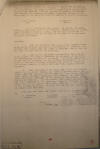
|
April 15, 1929.
Court-Martial of Filiberto Hernandez,
Voluntario General Juan Escamilla, et al.,
Encampment San Lorenzo, La Pavona, Jinotega
(English translation only), p. 2.
"In
this encampment San Lorenzo, La Pavona, 15,
April, 1929, at nine o’clock in the evening.
Meeting of the members for Court Martial, by
order of the Volunteer expeditionary chief
General Juan Escamilla, with the purpose of
knowing the charges made against the
prisoner Filiberto Fernandez, follow the
instructions of the case and from the
results it will be resolved. ¶
M.J. Corea Pte. ¶ D. Moncada
Scrio. ¶ In the encampment San
Lorenzo, La Pavona, 15 April, 1929, at half
past nine in the evening. Present were the
Fiscal Señor Wenceslao Espinoza Garcia, who
has been questioned to state the charges and
all he knew in the case of the prisoner
Filiberto Hernandez. ¶ Declared:
¶ 1. That the prisoner took part in
the Sandinist Banditry as an officer,
helping the destruction of property, and
killing with savage hand the lives of
harmless people, who did not want not take
part in the banditry. ¶ 2. That
by the prisoners own mouth he knew the
prisoner joined the files of banditry in the
month of May 1928, not remembering the date
of the month. The first commission he had
was at 'Vaqueano' on the 'Picada' of
Bocaycito to effect the capture of Maximo
Guerrero, who lived in Bocaycito; and
without knowing to which political band
Maximo Guerrero belonged. ¶ 3.
That belonged to the Sandinism, since the
time he stated in the second charge, his
blame of accomplice in the crime committed
against the citizens Dr. Juan Carlos
Mendieta, Julio Prado, Cayetano Castellon,
and murdered Don Juan Lopez, crime which was
committed in the valley of San Marcos,
jurisdiction of Jinotega. For the reason
that everything said here has been confessed
by the prisoner, I ask the Tribunal to blame
him, in the name of the public opinion, and
the Justice of the Nicaraguan family, to
apply him the capital punishment as example
for banditry. ¶ This has been said and
signed with me and my secretary, by: ¶
W. Espinoza Fiscal ¶ L. Rivera
Defender ¶ M. J. Corea Pte.
¶ D. Moncada, Sec."
|
|
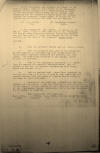
|
April 15, 1929.
Court-Martial of Isabel Rocha, Voluntario
General Juan Escamilla, et al., Encampment
San Lorenzo, La Pavona, Jinotega (English
translation only), p. 3.
"In the encampment San
Lorenzo, La Pavona, on the 15th of April,
1929, at six o’clock in the afternoon.
Meeting of the members of the Court-Martial
by order of the Volunteers expeditionary
chief, General Juan Escamilla for the
purpose of making known the charges against
the prisoner, Isabel Rocha, to follow the
instructions set forth in the case, and its
results. ¶ /s/ M. J. Corea. Pte.
¶ /s/ Deogracias Moncada Scrio.
¶ At the encampment, San Lorenzo, La
Pavona, on the 15th of April, 1929, at half
past six in the afternoon. The fiscal Senor
Wenceslao Espinoza Garcia was present, who
had been asked to state the charges and all
he knew relative to the case of the
prisoner, Isabel Rocha. ¶
Declared: ¶ 1. That the prisoner
formed part of Pedron’s group. ¶
2. That the prisoner took part in the crimes
committed against the citizens Dr. Juan
Carlos Mendieta, Julio Prado, Cayetano
Castellon and murdered Don Juan Lopez. The
foregoing occurred in SAN MARCOS,
jurisdiction of Jinotega. ¶ 3.
That by the prisoner’s testimony it is known
that he carried the bandit’s correspondence,
that he picked up men for the bandits,
threatening with death those who refused to
go. ¶ 4. That he carried mail
direct from Tiosimtal to La Pita and from La
Pita to La Boca de Cua, receiving the
communications from the hands of Nicolas
Davila carrying the same to Cisto [Sixto]
Gutierrez. ¶ Because of the
testimony rendered and the confession of the
bandit, I ask the Tribunal to find him
guilty in the name of public opinion and
well-fare and for the justice of the
Nicaraguan family, sentencing him to capital
punishment as an example to banditry.
¶ This being said and signed by:-
¶ M. J. COREA Fiscal ¶ L.
RIVERA, Defender ¶ M. J. COREA,
with me and my secretary Pte."
|
|
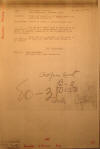
|
April 16, 1929.
"Trial and Execution of Isabel Rocha and
Filiberto Hernandez," Lt. H. H. Hanneken, La
Pavona, Jinotega (typed copy). "Enclosures:
Copies of trial of subject-named men.
¶ 1. The subject named bandits were
tried and sentenced to death by a
court-martial convened by order of General
Escamilla of the Volunteer Forces of
Nicaragua. ¶ 2. These men were
executed at day-break on the morning of
April 16, 1929 and were buried at LA PAVONA.
¶ /s/ H. HANNEKEN. ¶ Copy
to: Area Commander ¶ Northern
Area less enclosure."
|
|
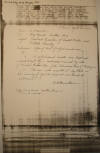
|
April 16, 1929.
"Trial and Execution of Isabel Rocha and
Filiberto Hernandez," Lt. H. H. Hanneken, La
Pavona, Jinotega (handwritten original).
[see above]
|
|
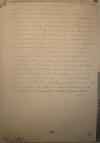
|
April 17, 1929.
"Report of Patrols," Lt. H. H. Hanneken, La
Pavona, Jinotega, p. 1.
"General Escamilla, 30
Volunteers cleared base at 0700 on April 15
with orders to proceed to house and finca of
Jesus Vasquez and to take into custody all
persons found there. (The Jefe Politico of
Jinotega informed Gen. Escamilla that Jesus
Vasquez and his men were bandits and
assassins in their areas.) Vasquez Finca is
located 6 miles N.E. of here on the Rio
Pita. Upon arrival of the patrol in that
vicinity a number of dogs gave the alarm and
all the occupants ran – 4 men and 2 women
and 2 children. The volunteers gave chase
and 2 volunteers who had outdistanced the
others caught up with the 4 men who were in
ambush along the trail and fired hitting one
(Felix Hernandez). Jesus Vasquez rushed at
the Volunteers with his machete and was
knocked down while the other 3 men including
the one who was founded. Patrol followed the
. . . "
|
|
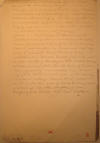
|
April 17, 1929.
"Report of Patrols," Lt. H. H. Hanneken, La
Pavona, Jinotega, p. 2.
" . . . trail of the 3
men but finally lost it. Patrol burned the
house and brought cattle to base for use of
Volunteers and Marines. Attached is a
statement of Jesus Vasquez. Patrol returned
to base with Jesus Vasquez, his wife, 2
daughters and one small child. Eulalio
Flores states that Jesus Vasquez and his 2
sons assassinated and robbed son Antonio
Garcia last January. ¶ April 16 – 2. Lieut.
Paige, 8 Marines and 30 Volunteers cleared
Base at 6:00 a.m. April 16 with orders to
proceed to Finca of one Vasilio Contreras
bandit and destroy his house and anything of
use to bandits. Vasilio Contrera's Finca is
situated near Quebrada Grande of Rio Pita
about 6 miles north of Chachagon Mts. Patrol
returned at 6:30 and reported that the house
of Contreras had apparently been vacated
only the morning of 16th. Patrol covered
area in the vicinity and found nothing.
Burned house. No cattle on finca. On trail
coming back to base patrol picked up two
other daughters of Jesus Vasquez who stated
that their brothers . . . "
|
|
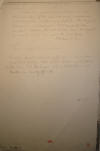
|
April 17, 1929.
"Report of Patrols," Lt. H. H. Hanneken, La
Pavona, Jinotega, p. 3.
" . . . had left and
were going to finca of Rafael Altamirano at
Los Robles. ¶ From all reports this
completes the destruction of the houses and
supplies of all bandits in the area La Pita,
Los Angeles, Guasanera-Chachagon Mts. and
all the bandits and women found have been
brought in and will be sent to Jinotega. ¶
H. Hanneken ¶ Copy to Comdr, Northern Area ¶ Received information this morning via runner
from Jefe Politico Jinotega that Pedron
killed a good Liberal Emilio Siles at Las
Cruces, between Embocadero and Guale on
Sunday April 14."
|
|
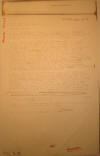
|
April 19, 1929.
"Report," Lt. H. H. Hanneken, La Pavona
(typed copy). "1.
Lt. Jordan and ration patrol arrived here at
1700 April 18 from Corinto Finca. No
contact. Have rations until May 1st. Private
Donald E. Rose of the 14th to 11th Rgt was
left at Corinto Finca due to an injured
foot. Request to be sent to Managua. ¶
2. Lt. Paige, 11 Marines, 30 Volunteers with
4 days rations cleared Base at 0630 April 19
to patrol to La Pita - Teocintal - La Flor -
Julio Guatemala’s on orders to destroy house
of Transito Gonzales situated at Teocintal.
(Gonzales is a bandit with Pedron). To
destroy champas of Carmen Garcia, about 2
miles from Teocintal. (At Carmen Garcia’s
place the following bandit spies hang out. 1
Nicolas Davila, 2. Transito Vasquez, 3.
Filiberto Hernandez, 4. Ignacio Calderon.
(The 2nd and 3rd have been apprehended at
the above place previously by my patrol.) To
destroy house of Tiburcia Garcia about 2
miles from La Flor. Tiburcia is the woman
living with Roseda Zelaya and she is the one
who sent a bandolier of ammunition to
Sandino and is a spy (well known ) of the
Bandits, and visits the Bandit camps when in
this area. She is the mother of Cruz Garcia
a prisoner at Garrobo. To inform all women
at Guatemala’s and at all other places to
proceed to Jinotega. ¶ The
following information was obtained by a
Colonel of the Volunteers while in Jinotega
at the office of the Jefe Politico.
That Jose Leon Diaz, Sebastian Centeno,
Ismael Peralta with about 10 men killed
Senor Siles at Las Cruces between Embocadero
and Guale, instead of Pedron Altamirano as
previously reported. That the son of
Siles, who was present when his father was
killed, escaped from the bandits and
reported in at Jinotega with information
that it was Diaz and not Pedron, and that
the bandits had very little ammunition; that
they had two machine guns with, about a drum
for same. ¶ 3. Further
rumor has it that Carlos Salgado has been
apprehended in Honduras. That Teresa
[Teresa Villatoro] (woman of Sandino), Juan
Colindres and Coronado Maradiaga have been
apprehended in Cifuentes, Honduras. ¶
4. I am expecting very definitive
information as to the whereabouts of Pedron,
his family, in a few days. ¶ 5. I
would like to know disposition of any other
Marine in or in the vicinity of this area. ¶
/s/ H. H. HANNEKEN"
|
|
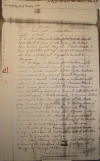
|
April 19, 1929.
"Report," Lt. H. H. Hanneken, La Pavona
(handwritten original), p. 1.
[see above]
|
|
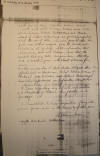
|
April 19, 1929.
"Report," Lt. H. H. Hanneken, La Pavona
(handwritten original), p. 2.
[see above]
|
|
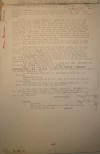
|
April 22, 1929.
"Memorandum: Area Commanders, Southern and
Northern Areas," Lt. H. H. Hanneken, La
Pavona.
"MEMORANDUM: Area
Commanders ¶ Southern and
Northern Area. ¶ 1. MANUEL
MATUTE (ex spy and bandit] who is now a spy
for my command, made a five day tour of
territory GUAPINOL – LOS CEDROS - ST HELENA
and reported back on April 21 with the
following information: ¶ (a)
That he found no signs of bandits in this
area with the exception of one AGATON, who
was sick and who had made the trip south and
return with Pedron. Agaton stated the
following: That Pedron went south to get
more recruits, but failed, in so doing; that
Pedron has about 40 men, that they are sick,
suffering with him, AGATON, permission to
remain at his finca and when Pedron returned
he could join again. Many others wanted to
go to their fincas and women but Pedron
would not allow them, stating that if they
did so, the Marines and Voluntarios would
get them and might result in their capturing
him, Pedron. ¶ That Pedron
stated he had to be at a conference of 3000
bandits near CHIPOTE and that afterwards he
would return to this area. ¶
That Sandino would soon be in power in
Managua and then they could all go down
there. AGATON states that Pedron and his
bandits now on the NORTH side of the Rio
Coco (my estimation is that he is in the
BENTILLA’s resting up from his last trip).
¶ That Pedron’s women are somewhere in
the GUAPINOL MTS. That JOSE RODRIGUEZ,
Honduran, Colonel and second in command with
Pedron, and their machine gun operator is
sick and has Pedron’s permission to go back
to Honduras. ¶ Two other spies
returned, one from Area CUA – BOCACITO and
the other LA VIRGEN and reported no bandits.
¶ Due to the fact that the area LOS
ANGELES – GUSANERA – CHACHAGON MTS – CUA –
LA FLOR – LA PITA are now clear of all
bandits and bandits families. ¶
1. My command will move to GUAPINOL on
Wednesday and Thursday. ¶
Recommendation: ¶ That a detachment of
Marines come to relieve my command at LA
PAVONA. ¶ That patrols be sent
into the BENTILLA MTS Area, which will rout
Pedron and bring him back here. ¶ I will
cover area LOS CEDROS – GUAPINOL – ST HELENA
to the RIO CUA and pursue Pedron at whatever
place he arrives. ¶ Patrol at LA
PAVONA will be of great aid should Pedron
get to the CUA area. ¶ H. H.
HANNEKEN. ¶ STRONG: ¶
Approved. ¶ Suggested by Col.
Dunlap that you have Guardia do the La
Pavona job. ¶ Schmidt."
|
|
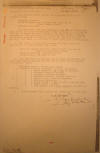
|
April 22, 1929.
"Report of Patrol," Lt. H. H. Hanneken, La
Pavona.
"1. The following
named bandits and spies were captured by
PAIGE’s Patrol ¶ Transito
Gonzales ¶ Felix Hernandez (who
got away the other day at Jesus Vasquez
Finca) ¶ Epifanio Hernandez.
¶ The latter two were also implicated
with the transportation of the 13 rifles and
ammunition from the finca of Juan Real to
the camp of Pedron and were identified by
Jesus Vasquez. Transito Gonzalez has been
identified as having been with Pedron by
MATUTE, by Transito Vasquez, and also by
report from the Jefe Politico of Jinotega.
All three will be tried by court martial by
the Volunteers. ¶ 2. The
following named men and boys have been sent
in to Jinotega to the Jefe Politico for
action. ¶ Transito Vasquez
(deserter from Pedron’s band due to help and
information given). ¶ Terensio
Calderon – 14 years of age. ¶
Mateo Garcia – 16 years of age ¶
3. The following reported in here on their
own volition and have proceeded to Jinotega
on April 22 to report to the Mission
Pacification there: ¶ Tiburcia
Garcia – bandit spy – woman. ¶
Families of Julio Guatemala – (bandit
supporter) ¶ Families of Tomas
Guatemala (in prison in Managua) ¶
Families of Transito Gonzales (Bandit)
¶ Families of Epifanio Hernandez
(Bandit) ¶ Families of Transito
Vasquez – (Bandit deserter) ¶
Families of Isabel Rocha – (bandit)
executed. ¶ Families of
Feliberto Hernandez – (Bandit) executed.
¶ Families of Jesus Picado – bandit in
prison Eastern Area ¶ Families
of Reyes Romero – Bandit ¶
Families of José Garcia and 6 other families
connections unknown. ¶ 4.
Nicolas Davila from reports has cleared out
of this area. ¶ H. H. HANNEKEN."
|
|
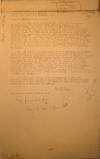
|
April 22, 1929.
"Patrol Report," 2nd Lt. Henry R. Paige, La
Pavona. "1.
At 08130 on 19 April 1929 Lt. Paige, 11
Marines and 20 Voluntarios cleared Base with
orders to proceed on the trail LA PAVONA –
LA PITA – LA FLOR – JULIO GUATEMALA and
instruct all families found in vicinity of
that trail to proceed immediately to LA
PAVONA and to destroy houses of bandit
families residing there. At 1415 patrol met
number of women coming down trail driving
cattle and carrying their effects. All said
they were going to JINOTEGA. I gave them
instructions to report at LA PAVONA to Lt.
Hanneken on their way. Patrol arrived at
TEOSINTAL at 1530. When house was approached
one of thirty Voluntarios reported that he
had seen a man run from the house. Later
this man was found in the woods nearby and
was discovered to be TRANSITO GONZALEZ,
alleged to be one of Altamirano’s bandits.
Camped for night at TEOSINTAL. NO CONTACT.
¶ At 0630 patrol cleared TEOSINTAL for
LA FLOR – JULIO GUATEMALLA’s – Instructed
families at JULIO GUATEMALA’S to proceed at
once to LA PAVONA. Patrol returned to LA
FLOR and visited houses of TIBURCIA GARCIA –
CARMEN GARCIA, EPIFANIO HERNANDEZ, and JOSE
GARCIA. House of TIBURCIA GARCIA had already
been burned. EPIFANIO HERNANDEZ, alleged
bandit, was captured as he ran from his
house. CHAMPAS of CARMEN GARCIA, bandit
hangout, and EPIFANIO HERNANDEZ were burned.
At JOSE GARCIA’s patrol captured FELIX
HERNANDEZ deserter from finca guard at
JINOTEGA and alleged bandit. All families
returned with patrol to TEOSINTAL – Patrol
camped there at 1900 – NO CONTACT. ¶
3. 21 April – Patrol cleared TEOSINTAL at
0730 with prisoners mentioned. Houses of
ISABEL ROCHA and TRANSITO GONZALES were
burned. Patrol arrived at LA PAVONA at 1300
and turned over prisoners to Lt. Hannekan.
NO CONTACT. ¶ H. R. Paige
¶ 2nd Lt. USMC. ¶ Copy to
Area Comdr. Northern Area."
|
|
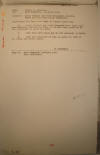
|
April 23, 1929.
"Jesus Vasquez and Felix Hernandez, Bandits,
trial and execution of by Volunteers," Lt.
H. Hanneken, La Pavona.
"Enclosures: (2)
Copies of trial of subject named men.
¶ 1. Jesus Vasquez and Felix Hernandez
were tried by a court-martial convened by
order of General Juan Escamilla of the
Volunteers on April 22, 1929. ¶
2. They were both found guilty and sentenced
to death. ¶ 3. They were executed at 1800 on
April 22, 1929 at La Pavona and buried
there. ¶ H. HANNEKEN. ¶
Copy to: Area Commander Northern Area less
enclosures."
|
|
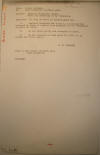
|
April 24, 1929.
"Epifanio Hernandez, Bandit. Trial and
execution of by Volunteers," Lt. H. H.
Hanneken.
"Enclosures: (1) Copy
of trial of subject-named man. ¶
1. Epifanio Hernandez was tried by a
court-martial convened by order of General
Juan Escamilla of the Volunteers on April
23, 1929. ¶ 2. He was found
guilty and sentenced to death. ¶
3. He was executed at 1800 April 23, 1929,
at LA PAVONA and buried there. ¶
H. H. HANNEKEN ¶ Copy to Area
Comdr. Northern Area less enclosure. ¶
ORIGINAL."
|
|
_small.jpg)
|
April 24, 1929.
"Capturas de
Escamilla," La Tribuna (Managua).
"El Gral.
Escamilla capturó en el campamento de La
Pavona a seis desertores de Pedrón
Altamirano, con sus rifles. También a
dos mujeres que llevaban correspondencia; y
a diecinueve más que estaban escondidas,
esposas de otros tantos hombres de la
columna del mismo Pedrón."
|
|
|
|
|
End of Page 2.
|
|
|
|
|
|
|
|
|
|
TOP OF PAGE
|
|
|
|

